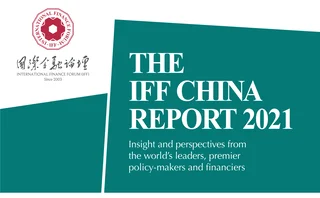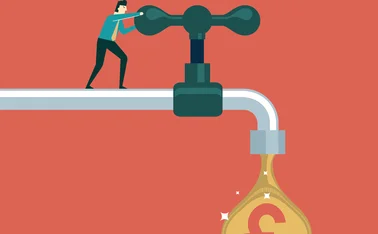
Green finance for carbon neutrality


As the effects of the Covid-19 pandemic continue to spread around the world, countries have been prioritising containment and economic recovery. The shift in focus has slowed, to a degree, the actions of global climate governance and the UN’s 2030 Sustainable Development Goals (SDGs). The impacts of the pandemic will be short-term, yet the risks and challenges of climate change will remain for much longer. Nations have been committed to rigorous measures for green and low-carbon recovery and development, and keeping the post-pandemic recovery measures on track as the 2030 Agenda for the SDGs deadline approaches. Against the backdrop of a complex and constantly changing international situation, green finance – and especially climate finance – is expected to become a major driving force in opening up China’s financial sector, and supply-side structural reform in the financial sector under the new development paradigm of a ‘dual circulation’ (domestic and international) economy.
Since China’s 13th Five Year Plan (2016–20), China has made significant progress in green finance, especially in formulating green standards, developing incentive mechanisms, conducting environmental risk disclosure, innovating products and implementing local pilot projects. China has made initial progress in establishing a comprehensive policy system and market environment that supports the development of green finance.

Green finance has played an important role in promoting the green transition, the high-quality development of the economy, and pollution prevention and control. As of June 30, 2020, China’s green credit balance has exceeded CNY11 trillion – the highest in the world. Its stock of green bonds totals CNY1.2 trillion – the second-largest in the world. Since 2017, the State Council of the People’s Republic of China has approved six provinces and nine cities as pilot zones for green finance reform and innovations, and their experience has strongly supported the development of local green industries and economic transformation. As of June 30, 2020, the balance of green loans in the pilot zones has exceeded CNY200 billion, accounting for 12.2% of their total loan balance, 2% higher than the national average. The balance of green bonds was nearly CNY120 billion, an increase of 83% year-on-year. The total number of green projects included in the pilot zone green project catalogue is more than 2,200, with the cumulative investment exceeding CNY1.87 trillion.
Neutral tones
Climate change has become the most critical environmental and developmental challenge facing mankind in the 21st century. Addressing climate change is vital to achieving global sustainable development for years to come. Moreover, it directly affects the modernisation of developing countries. The total amount of global climate investment and financing has increased since the adoption of the Paris Agreement on climate change. In 2017, the total amount reached US$612 billion. However, policy changes in east Asia and the Pacific region, global economic slowdown and the declining costs of renewable energy have led to global climate finance plummeting to $546 billion in 2018. Innovative changes are urgently needed. In response, a number of key economies, development finance institutions and the private sector have made climate commitments and are phasing out or are about to divest from fossil fuels. In 2019, the European Union proposed the Green New Deal, a plan to invest €1 trillion over the next 10 years in sustainable development, in particular to address climate change.
In September 2020, at the general debate of the 75th session of the UN General Assembly, President Xi Jinping announced: “China will scale up its intended nationally determined contributions (NDCs) by adopting more vigorous policies and measures. We aim to have carbon dioxide emissions peak before 2030 and achieve carbon neutrality before 2060.” President Xi’s pledge indicates China’s stronger action to regulate fossil energy consumption, strictly control coal consumption and control the scale of coal-fired power plants. Meanwhile, China will step up its efforts to promote the development of non-fossil energy, including developing renewable energy and industries where renewable energy can be extensively applied.
A study by the Institute of Climate Change and Sustainable Development (ICCSD) at Tsinghua University has explored China’s potential pathway to achieving carbon neutrality by mid-century. If China adopts the study’s recommended pathway in its climate strategy, it needs to formulate more ambitious energy-saving and emissions reduction targets in the 14th Five Year Plan (2021–25) for National Economic and Social Development and the Long-Range Objectives Through the Year 2035 and its 2030 NDC, and promote rapid deep decarbonisation after 2030.
In November 2020, the Central Committee of the Communist Party of China released its proposals for formulating the 14th Five Year Plan (2021–25). The proposals include reducing carbon emission intensity, supporting regions to take the lead in peaking carbon emissions and formulating action plans for peaking carbon emissions by 2030.
Guiding lights
To help achieve the commitment made by President Xi, relevant ministries jointly issued Guiding opinions on promoting investment and financing to address climate change in October 2020, proposing 15 steps in five areas. Major measures include:
- To accelerate the development of a climate investment and financing policy system
- To improve the climate investment and financing standard system, including climate information disclosure standards and climate performance evaluation standards
- To encourage and leverage private and foreign capital to engage in climate investment and financing
- To guide and support local practices in climate investment and financing
- To develop local pilots for climate investment and financing
- To create an enabling local policy environment and encourage local innovation in models and instruments.
These measures will facilitate the implementation of climate investment and financing policies at local level.
In regard to leveraging finances, the Guiding opinions emphasise stimulating the motivation and vitality of private capital and promoting co-operation between the public and private sectors through such means as public–private partnership. It also encourages “enterprises and institutions to fully consider the impact of the future carbon price on their investment activities”, which will promote enterprises to manage transitional risk related to climate change, such as using a higher internal carbon price in the feasibility study of project investment. As the national carbon market becomes operational, the Guiding opinions intend to support the development of the carbon market, explore derivatives products and businesses such as carbon futures, and establish funds related to the carbon market.
Fully recognising the global challenge of climate change, the Guiding opinions also encourage international financial institutions and foreign investors to engage in climate finance in China, establish yuan-denominated overseas green investment funds, and hold green financial assets in renminbi. It is expected that climate investment and financing activities will actively support and promote the internationalisation of the renminbi by leveraging efforts to address climate change as an important step in building a shared future for mankind. The Guiding opinions also promote Chinese enterprises to conduct climate-friendly overseas investment as well as identify and mitigate climate risks, with special emphasis on South–South and Belt and Road Initiative co-operation, showcasing the responsibility of Chinese investors.
Only users who have a paid subscription or are part of a corporate subscription are able to print or copy content.
To access these options, along with all other subscription benefits, please contact info@centralbanking.com or view our subscription options here: subscriptions.centralbanking.com/subscribe
You are currently unable to print this content. Please contact info@centralbanking.com to find out more.
You are currently unable to copy this content. Please contact info@centralbanking.com to find out more.
Copyright Infopro Digital Limited. All rights reserved.
As outlined in our terms and conditions, https://www.infopro-digital.com/terms-and-conditions/subscriptions/ (point 2.4), printing is limited to a single copy.
If you would like to purchase additional rights please email info@centralbanking.com test test test
Copyright Infopro Digital Limited. All rights reserved.
You may share this content using our article tools. As outlined in our terms and conditions, https://www.infopro-digital.com/terms-and-conditions/subscriptions/ (clause 2.4), an Authorised User may only make one copy of the materials for their own personal use. You must also comply with the restrictions in clause 2.5.
If you would like to purchase additional rights please email info@centralbanking.com test test test







